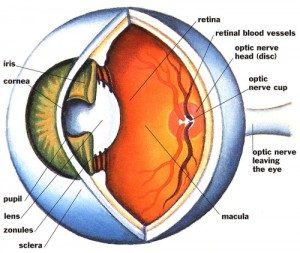Lutein and Zeaxanthin for Thyroid Eye Disease

I have been asked many times about Thyroid Eye Disease treatment (Graves’ Eye Disease) and if there is anything else that can do to improve their eye condition besides the usually recommended Flax Seed oil, eye exercises, cold compresses etc. As a former Thyroid Eye Disease sufferer and a member of the International Thyroid Eye Disease Society I have been researching this topic for years.
Well, it appears that there is something that can improve your condition: Lutein and Zeaxanthin, important nutrients mostly found in green leafy vegetables and all those from Brassica Family (broccoli, spinach, and kale). The last are not only good for inhibiting the overproduction of thyroid hormone, but they appear to positively influence our eyes as well. So, what exactly are these strange sounding and not so popular nutrients?
As the American Optometric Association advises us, these carotenoids actually filter the harmful high-energy blue wavelengths of light and act as antioxidants in the eye, helping protect and maintain healthy cells. They also appear to reduce the risk of chronic eye diseases including the including age-related macular degeneration (AMD) and cataracts. Of the 600 carotenoids found in nature, only two are deposited in high quantities in the retina (macula) of the eye: lutein and zeaxanthin. Accordingly, do you think we should take them as supplements? I say yes, and I’ve tried them on my own as well. Recently I had to read a lot on the computer and sometimes spent more than 10 hours daily, which for me is a lot. Of course, I don’t have the Thyroid Eye disease any more, but my eyes will get so tired by the end of the day that I can hardly read my books. So I decided to give it a try for a few months. Needless to say my vision became better, I did not have to wear computer glasses all the time and the tiredness was reduced significantly. Plus, sometimes in the evenings it’s difficult for me to drive, but now I have noticed that this inconvenience disappeared as well. What to blame? I say- the Lutein and Zeaxanthin, which I’ve been taken daily for the last 2 months as supplements.
Unfortunately, the human body does not synthesize the lutein and zeaxanthin it needs, which is the reason why green vegetables are essential to good nutrition. Daily intake of lutein and zeaxanthin through diet, nutritional supplements, or other foods and beverages is important for the preservation of good eye health.
How this actually works and how cataracts for example could be prevented, not to mention the blurry vision that pretty much all patients with Graves’ Eye Disease have.
The primary function of the natural lens in the eye is to collect and focus light on the retina. To appropriately provide this function throughout life, the lens must remain clear. It’s like cleaning your windows from time to time, because they become dirty. As for the eye it happens through oxidation and this is the major cause of cataracts, which cloud the lens. As antioxidant nutrients neutralize free radicals associated with oxidative stress and retinal damage, lutein and zeaxanthin likely play a role in cataract prevention. In fact, a recent study demonstrated that higher dietary intakes of lutein and zeaxanthin and vitamin E was associated with a significantly decreased risk of cataract formation.
Lutein and Zeaxanthin also help the Age-Related Macular Degeneration. Recently the The National Eye Institute conducted a second large human clinical trial, Age-Related Eye Disease Study (AREDS2), to confirm whether supplements containing 10 mg a day of lutein and 2 mg of zeaxanthin per day affect the risk of developing of mascular degeneration. Beyond reducing the risk of developing eye disease, separate studies have shown that lutein and zeaxanthin improve visual performance in AMD patients, cataract patients and individuals with good health. Though there is no recommended daily intake for lutein and zeaxanthin, most recent studies show a health benefit for lutein supplementation at 10 mg/day and leaxanthin supplementation at 2 mg/day.
You may say that Thyroid Eye disease treatment has nothing to do with cataracts and aged-related muscle degeneration, but trust me, it does. With Thyroid eye disease your vision is blurred, clouded, and your eye muscles have been extended (as the eye is pushed out of its socket) and they can hardly contract to normal position again without surgery for example. But this is what lutein and zeaxanthin actually do- they prevent the muscular degeneration, and I would say improve as well.
Lutein and zeaxanthin as a combination are sold over the counter in many food or general stores (Walmart, Walgreens, Right Aid, ect.) in the USA and they are pretty affordable as a price, depending on the producer. Follow the instructions on the label.
As disclosed by the American Optometric association the following table contains the amount of these two important nutrients in our food:
| Lutein and Zeaxanthin Foods | ||
| Food | Serving | mg |
| Kale (cooked) | 1 cup | 23.7 |
| Spinach (cooked) | 1 cup | 20.4 |
| Collards (cooked) | 1 cup | 14.6 |
| Turnip greens (cooked) | 1 cup | 12.2 |
| Spinach (raw) | 1 cup | 3.7 |
| Green Peas (canned) | 1 cup | 2.2 |
| Corn (canned) | 1 cup | 2.2 |
| Broccoli (cooked) | 1 cup | 1.7 |
| Romaine lettuce (raw) | 1 cup | 1.3 |
| Carrots (cooked) | 1 cup | 1.1 |
| Green beans (cooked) | 1 cup | 0.8 |
| Eggs | 2 (large) | 0.3 |
| Source: USDA National Nutrient Database for Standard Reference, Release 22 (2009) | ||
For more information about Thyroid Eye Disease Remedies, check the following links:
Thyroid Eye Disease Natural Cures
Flax seed oil and Thyroid Eye Disease
10 Ways to improve Thyroid Eye Disease
